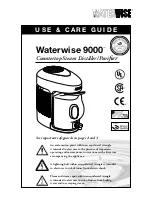
19
ENGLISH
Be sure to give insulation work to refrigerant piping by covering liquid
pipe and gas pipe separately with enough thickness heat-resistant poly-
ethylene, so that no gap is observed in the joint between indoor unit
and insulating material, and insulating materials themselves. When in-
sulation work is insufficient, there is a possibility of condensation drip,
etc. Pay special attention to insulation work to ceiling plenum.
Ⓐ
Heat insulation material
Ⓑ
Pipe
Ⓒ
Outer covering(Wind the connection part and cutting part of heat in-
sulation material with a finishing tape.)
Heat insulation
material
Ad Heat - resistant poly-
ethylene foam + Adhesive tape
Outer
covering
Indoor
Vinyl tape
Floor ex-
posed
Water-proof hemp cloth +
Bronze asphalt
Outdoor
Water-proof hemp cloth +
Zinc plate + Oily paint
NOTE
!
When using polyethylene cover as covering material, asphalt roof-
ing shall not be required.
Bad example
Thermal insulation of refrigerant piping
• Do not insulate gas or low pressure pipe and liquid or highpres-
sure pipe together.
• Be sure to fully insulate connecting portion.
Ⓐ
These parts are not insulated.
Ⓐ
Liquid pipe
Ⓑ
Gas pipe
ⓒ
Power lines
ⓓ
Finishing tape
ⓔ
Insulating material
ⓕ
Communication lines
A
C
D
E
B
F
A
Good example
Ⓐ
Liquid pipe
Ⓑ
Gas pipe
ⓒ
Power lines
ⓓ
Insulating material
ⓔ
Communication lines
Communication lines
Separation
Power lines
E
D
D
B
A
C
A
B
E
B
I
A
B
D
C
1m
1m
D
F
G
B
G
D
B
H
I
J
A
Penetrations
Ⓐ
Sleeve
Ⓑ
Heat insulating material
Ⓒ
Lagging
Ⓓ
Caulking material
Ⓔ
Band
Ⓕ
Waterproofing layer
Ⓖ
Sleeve with edge
Ⓗ
Lagging material
Ⓘ
Mortar or other incombustible caulking
Ⓙ
Incombustible heat insulation material
When filling a gap with mortar, cover the penetration part with steel plate so
that the insulation material will not be caved in. For this part, use incom-
bustible materials for both insulation and covering. (Vinyl covering should not
be used.)
Inner wall (concealed)
Outer wall
Outer wall (exposed)
Floor (fireproofing)
Penetrating portion on fire
limit and boundary wall
Roof pipe shaft
Caution
- Follow ordinance of your governmental organization for technical
standard related to electrical equipment, wiring regulations and guid-
ance of each electric power company.
- Install the Outdoor Unit communication cable away from the power
source wiring so that it is not affected by electric noise from the power
source. (Do not run it through the same conduit.)
- Be sure to provide designated grounding work to Outdoor Unit.
- Give some allowance to wiring for electrical part box of Indoor and
Outdoor Units, because the box is sometimes removed at the time of
service work.
- Never connect the main power source to terminal block of communi-
cation cable. If connected, electrical parts will be burnt out.
- Use 2-core shield cable for communication cable.( mark in the fig-
ure below) If communication cable of different systems are wired
with the same multiplecore cable, the resultant poor transmitting and
receiving will cause erroneous operations. ( mark in the figure
below)
- Only the communication cable specified should be connected to the
terminal block for Outdoor Unit communication.
CAUTION
Be sure to correct the outdoor unit to earth. Do not connect ground
wire to any gas pipe, liquid pipe, lightening rod or telephone earth
line. If earth is incomplete, it may cause an electric shock.
!
WARNING
Be sure to have authorized electrical engineers do the electric
work using special circuits in accordance with regulations and this
installation manual.
If power supply circuit has a lack of capacity or electric work defi-
ciency, it may cause an electric shock or fire.
!
ELECTRICAL WIRING















































